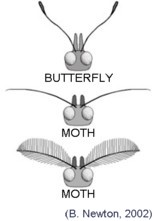|
|
ARTHROPODS:
Insects»
Spiders»
Centipedes»
Millipedes»
Sowbugs»
Harvestmen»
Mites
& Ticks»
Scorpions»
Identification
Tips»
About
the Critter Files»
Links» |
|
|
|
| COMMON KENTUCKY BUTTERFLIES: |
|
|
|
|
|
|
| |
|
|
|
|
|
|
|
|
|
| CATERPILLARS
OF COMMON KENTUCKY BUTTERFLIES: |
|
|
|
|
|
|
|
|
|
|
|
|
|
|
|
|
|
| COMMON KENTUCKY MOTHS: |
|
|
|
|
|
|
|
|
|
|
|
|
| COMMON KENTUCKY MOTH CATERPILLARS: |
|
|
|
|
|
|
|
|
|
|
|
|
|
|
|
|
|
| |
| WHAT
ARE BUTTERFLIES & MOTHS? |
|
Butterflies
and moths may be the most familiar of all insects. They also may be
the easiest to recognize, with their unique coiled mouthparts and
their large, scaled wings. The color patterns on butterfly
and moth wings are created by tiny, overlapping "scales" (much
like the scales on reptiles, only much smaller). These scales
appear only among butterflies and moths. |
| |
|
|
|
ABOVE:
Close-up of butterfly mouthparts. When a butterfly
or moth is not drinking, its "tongue" is wound into a tight coil.
The tongue is actually a tube, and it is able to extend and
siphon water and nectar. This type of mouthpart, called "siphoning,"
is unique to moths and butterflies. (Corel Photo CD, 1993) |
| |
| WHAT IS THE DIFFERENCE BETWEEN BUTTERFLIES AND MOTHS? |
|
 Butterflies and moths
are closely related (they are in the same scientific order, Lepidoptera). Moths and butterflies both also have coiled
mouthparts and scaly wings, so it is sometimes difficult to tell
the difference between moths and butterflies. In most cases,
butterflies fly during the day, and moths fly at night. However,
this is not always true. Butterflies and moths
are closely related (they are in the same scientific order, Lepidoptera). Moths and butterflies both also have coiled
mouthparts and scaly wings, so it is sometimes difficult to tell
the difference between moths and butterflies. In most cases,
butterflies fly during the day, and moths fly at night. However,
this is not always true.
RIGHT: The best way to distinguish butterflies from moths is by their antennae:
moth antennae are either straight and bare, or feathery. Butterfly
antennae are always straight with a distinct "knob" at
the end. Moth antennae never have knobs. |
| |
| There are
many different kinds of butterflies and moths in Kentucky. Click on the
pictures above to learn more about specific types of adult butterflies and moths.
Or, visit the Caterpillars section to identify butterfly and moth caterpillars. |
| |
|
Original document: 25 May 2004
Last updated: 12 March 2004
Photos courtesy R. Bessin and B. Newton, University of Kentucky
The Kentucky Critter
Files are maintained by Blake Newton, Department of Entomology, University
of Kentucky.
Contact: blaken@uky.edu |
|

